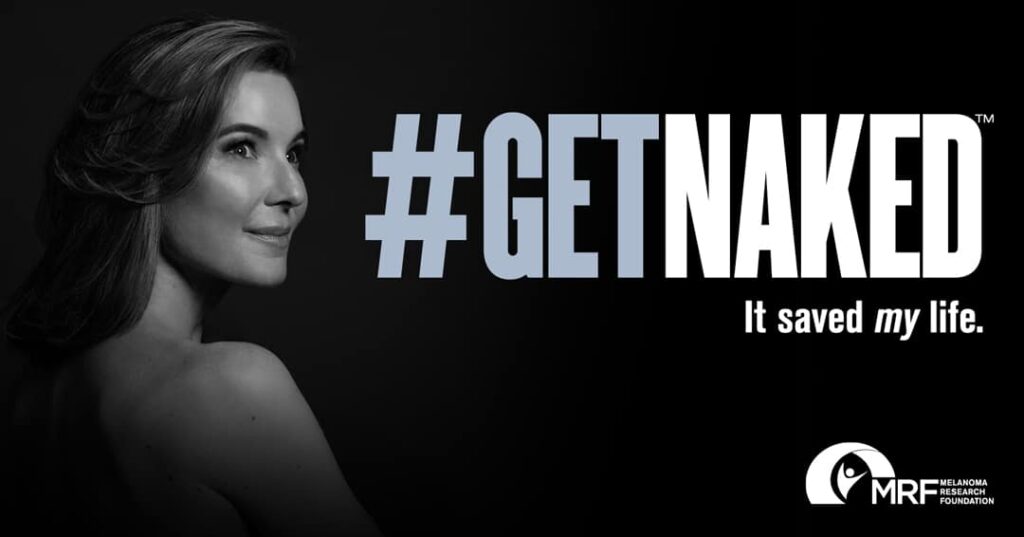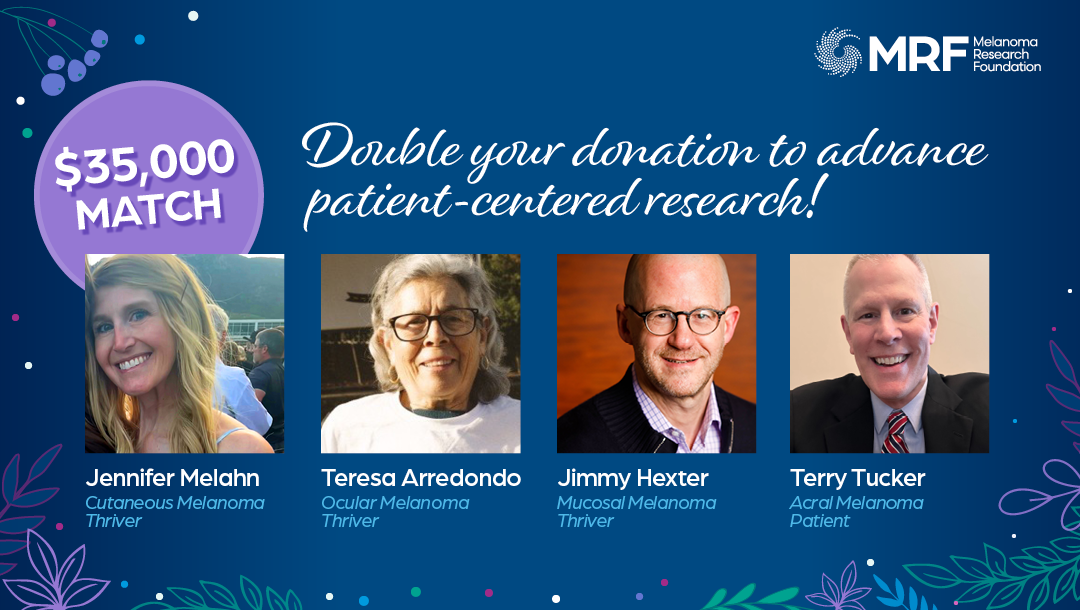#GetNaked: It Saved My Life


Guest Blog SUBMITTED BY
Ellen Marmur, MD
Guest blog post by Ellen Marmur, MD. The recipient of a 2017 MRF Humanitarian Award, Dr. Marmur is a leading dermatologist and dermatologic surgeon, a recognized and admired expert in skin cancer diagnosis and surgery, Mohs surgery, reconstructive surgery, cosmetic surgery and women’s health dermatology. Dr. Marmur founded Marmur Medical in 2012, and is an Associate Clinical Professor in both the Department of Dermatology and the Department of Genetics & Genomic Research at The Icahn School of Medicine at Mount Sinai. Dr. Marmur is also a melanoma survivor.

I am a skin cancer surgeon specializing in Mohs surgery and melanoma detection. When I recognized each of my own skin cancers, time stood still for a moment. That spot on my right nose looked too pink for too long… the red spot under my left eye seemed odd… and the black speck beside my left knee is new. Each time I showed other skin cancer specialists and each time I was reassured it was normal, or acne, or something we can watch. And each time I insisted on a biopsy, despite the risk of scars. My sense was that it was abnormal and I wanted it off my body, immediately! I was in my thirties, having my babies, and starting my career as Chief of Dermatologic & Cosmetic Surgery at the Mount Sinai Hospital in New York City and I already had three skin cancers.
My skin cancers were silent, without any symptoms like pain or itch. But they triggered my radar about my health. It’s hard to explain, but when you’ve faced illness, you just know something isn’t right. For all my knowledge from 12 years of medical training and treatment of thousands of skin cancers as a dermatologic surgeon, my detection of my skin cancers was as scientific as a hunch. The spot just didn’t seem like all of the others. I tell my patients, “if your spider sense signals an alert about any spot on your body, come see a real dermatologist immediately.” Board certified dermatologists might be hard to find in some areas of the world, but skin cancers can mimic benign looking things and can fool even the best of doctors or physician assistants or nurses, so make sure you see a real dermatologist.
For the skin cancers on my face, I had Mohs surgery which is the best minimalist approach to removing non-melanoma skin cancers like basal cell carcinoma and squamous cell carcinoma. The goal is to preserve normal tissue and function, in my case the movement of my lower eyelid and the ability to inhale normally with my nose. I was so completely focused on ridding my body of cancer, I didn’t care at all how my face would appear after. Surgeons have to learn to compartmentalize our feelings when removing tissue–like when I recently removed the entire external ear from a 90-year-old, lovely Hispanic woman because the skin cancer threatened to eat into her nerves and blood vessels where it could spread. So as a surgeon/patient/new mother, I automatically controlled my fears in favor of logic and better health. I even went to our skin cancer national meeting with stitches dangling under my left eye.
Having non-melanoma skin cancer multiplies your risk of having melanoma by an estimated twenty-five times! I was shocked but not surprised when the new black speck on my knee was diagnosed as an early melanoma. Thank goodness I had it biopsied so early. Melanoma is not what you want. Unlike other skin cancers which spread like a tree with long roots connected to the trunk, melanomas can spread by one rogue cell. Single melanoma cells can travel away from the visible cancer and grow in lymph nodes and other organs. Plus, melanoma cells are smart. The surface of each cell has a characteristic set of receptors on it, imagine the skin of all red grapes having identical surface markings. Immune cells called natural killer cells can determine if a cell is normal or cancerous by its surface markings. If it sees a bad cell, it kills it and sends out a signal for all of the other killer cells to search and destroy other bad cells. This is great, right? But melanoma outsmarts our immune cells and morphs itself to remain under the radar for a while. These are a few of the reasons why it’s been so hard to invent targeted treatments for melanoma. We are getting closer and closer with research and clinical studies and repurposing treatments for other cancers to successfully work on melanoma. My early melanoma was excised with a wide margin and stitched up beautifully by another dermatologic surgeon. I was back on the squash court in 3 days with blue stitches holding my skin tight.
The irony of being a skin cancer specialist with skin cancer has been a blessing. Patients come for surgery and are so anxious. I point to my scars, tell them how only my brothers make fun of the white scar on my nose and say I have sugar on it, or show that I can’t even find the scars under my eye or knee. I know how the needle feels and how the numbing medicine burns. I know how intense the OR light is on the eyes. I know how important it is to tell someone what is happening, how it’s going, what is next, what to be concerned about. I often say, “It’s my job to worry for you. You focus on healing. I will call you as soon as I have the results.”
Another blessing of such an early wake up call to cancer is how to prevent it. Skin cancer can be from genetics, sun damage, cigarette smoking, chronic wounds, pollution or a number of other unknown variables. We can control a few of these–like no more suntans, no more sunburns, no smoking or vaping, and seeing a board-certified dermatologist for a #GetNaked skin check every single year. See an ophthalmologist to check for ocular melanoma of the uvea of the eye. See a dentist for a tissue check in the mouth for white, red, black, brown spots. And for women, see a gynecologist yearly. Self-skin checks find 80% of skin cancers–so trust your spider sense, too! Show us anything that bothers you within days to weeks, not months to years.
Sun protection means sunscreen and hats and sunglasses and long sleeves and long skirts or pants. It means reapplying sunscreen every 1-2 hours and never forgetting your big hat. Despite any sunscreen warnings, the known risks of skin cancer from sun exposure merit using sunscreen.
Since my skin cancers, I’ve insisted on more skin biopsies on my face and so far so good! I started a philanthropy called Skin Cancer, Take a Hike! We’ve hiked up Kilimanjaro, Patagonia, Alaska, the USA and Iceland to raise money to prevent, detect, and heal skin cancers. We’ve built shade structures in zoos and athletic fields to protect people from excess sun. We’ve conducted free skin cancer exams and provided free sun-protection all over the world. I’m committed to raising awareness with the wonderful team at the Melanoma Research Foundation and telling the world to #GetNaked and get your skin checked. I #gotnaked and it saved my life.
As a dermatologist and dermatologic surgeon, Dr. Marmur is on the front lines in the fight against melanoma. As a melanoma survivor, she in one of the more than one million people in the United States who have been affected by the deadliest form of skin cancer, many of whom were the first to discover it during a self-skin exam. May is Melanoma Awareness Month, so don’t forget your own monthly skin check and please consider a tax-deductible donation to the MRF to support the physicians, researchers, patients and caregivers who are leading the fight against melanoma.




